Land Surface Temperature Regulation Ecosystem Service: A Case Study of Jaipur, India, and the Urban Island of Jhalana Reserve Forest
Abstract
:1. Introduction
2. Materials and Methods
2.1. Study Area
2.2. Data Collection
2.3. Data Processing
2.4. Data Analysis and Analysis Categories
2.5. Statistical Techniques
3. Results
3.1. Zonal Analysis
3.2. Seasonal Analysis
3.3. Demi-Decadal Analysis
4. Discussion
5. Conclusions
- The Urban Cooling effect in the urban and rural areas of Jaipur, i.e., JRF acting as a heat sink;
- Summer LSTs are on the rise based on our multi-decadal comparisons, but the relatively low LSTs in JRF remain constant in all of the seasons throughout the years;
- A significant difference in LST was observed among and between the three study zones, with JRF always being the lowest in all of the three seasons;
Author Contributions
Funding
Data Availability Statement
Conflicts of Interest
Abbreviations
References
- Gogoi, P.P.; Vinoj, V.; Swain, D.; Roberts, G.; Dash, J.; Tripathy, S. Land use and land cover change effect on surface temperature over Eastern India. Sci. Rep. 2019, 9, 8859. [Google Scholar] [CrossRef] [PubMed]
- Rajeshwari, A.; Mani, N.D. Estimation of Land Surface Temperature of Dindigul District Using Landsat 8 Data. Int. J. Res. Eng. Technol. 2014, 3, 122–126. [Google Scholar] [CrossRef]
- Sahana, M.; Ahmed, R.; Sajjad, H. Analyzing land surface temperature distribution in response to land use/land cover change using split window algorithm and spectral radiance model in Sundarban Biosphere Reserve, India. Model. Earth Syst. Environ. 2016, 2, 81. [Google Scholar] [CrossRef]
- Gohain, K.J.; Mohammad, P.; Goswami, A. Assessing the impact of land use land cover changes on land surface temperature over Pune city, India. Quat. Int. 2021, 575–576, 259–269. [Google Scholar] [CrossRef]
- Witherick, M.; Ross, S.; Small, J. A Modern Dictionary of Geography, 4th ed.; Oxford University Press: Oxford, UK, 2001; ISBN 034080713X. [Google Scholar]
- Rasul, A.; Balzter, H.; Smith, C. Diurnal and Seasonal Variation of Surface Urban Cool and Heat Islands in the Semi-Arid City of Erbil, Iraq. Climate 2016, 4, 42. [Google Scholar] [CrossRef]
- Hou, H.; Estoque, R.C. Detecting Cooling Effect of Landscape from Composition and Configuration: An Urban Heat Island Study on Hangzhou. Urban For. Urban Green. 2020, 53, 126719. [Google Scholar] [CrossRef]
- Kolokotsa, D.; Psomas, A.; Karapidakis, E. Urban heat island in southern Europe: The case study of Hania, Crete. Sol. Energy 2009, 83, 1871–1883. [Google Scholar] [CrossRef]
- Peng, J.; Jia, J.; Liu, Y.; Li, H.; Wu, J. Seasonal contrast of the dominant factors for spatial distribution of land surface temperature in urban areas. Remote Sens. Environ. 2018, 215, 255–267. [Google Scholar] [CrossRef]
- Zhou, B.; Rybski, D.; Kropp, J.P. The role of city size and urban form in the surface urban heat island. Sci. Rep. 2017, 7, 4791. [Google Scholar] [CrossRef]
- Zhao, Z.Q.; He, B.J.; Li, L.G.; Wang, H.B.; Darko, A. Profile and concentric zonal analysis of relationships between land use/land cover and land surface temperature: Case study of Shenyang, China. Energy Build. 2017, 155, 282–295. [Google Scholar] [CrossRef]
- Peng, X.; Wu, W.; Zheng, Y.; Sun, J.; Hu, T.; Wang, P. Correlation analysis of land surface temperature and topographic elements in Hangzhou, China. Sci. Rep. 2020, 10, 10451. [Google Scholar] [CrossRef] [PubMed]
- Sarricolea, P.; Meseguer-Ruiz, O. Urban climates of large cities: Comparison of the urban heat Island effect in Latin America. In Urban Climates in Latin America; Springer: Cham, Switzerland, 2019; pp. 17–32. [Google Scholar] [CrossRef]
- Zhou, W.; Cao, F. Effects of changing spatial extent on the relationship between urban forest patterns and land surface temperature. Ecol. Indic. 2020, 109, 105778. [Google Scholar] [CrossRef]
- Mohan, M.; Kikegawa, Y.; Gurjar, B.R.; Bhati, S.; Kolli, N.R. Assessment of urban heat island effect for different land use-land cover from micrometeorological measurements and remote sensing data for megacity Delhi. Theor. Appl. Climatol. 2013, 112, 647–658. [Google Scholar] [CrossRef]
- Veena, K.; Parammasivam, K.M.; Venkatesh, T.N. Urban Heat Island studies: Current status in India and a comparison with the International studies. J. Earth Syst. Sci. 2020, 129, 85. [Google Scholar] [CrossRef]
- Guha, S.; Govil, H.; Dey, A.; Gill, N. A case study on the relationship between land surface temperature and land surface indices in Raipur City, India. Geogr. Tidsskr. Danish J. Geogr. 2020, 120, 35–50. [Google Scholar] [CrossRef]
- Shigeta, Y.; Ohashi, Y.; Tsukamoto, O. Urban Cool Island in Daytime-Analysis by Using Thermal Image and Air Temperature Measurements. In Proceedings of the Seventh International Conference on Urban Climate, Yokohama, Japan, 29 June–3 July 2009; pp. 3–6. [Google Scholar]
- Yang, C.; He, X.; Wang, R.; Yan, F.; Yu, L.; Bu, K.; Yang, J.; Chang, L.; Zhang, S. The Effect of Urban Green Spaces on the Urban Thermal Environment and Its Seasonal Variations. Forests 2017, 8, 153. [Google Scholar] [CrossRef]
- Lazzarini, M.; Marpu, P.R.; Ghedira, H. Temperature-land cover interactions: The inversion of urban heat island phenomenon in desert city areas. Remote Sens. Environ. 2013, 130, 136–152. [Google Scholar] [CrossRef]
- Rasul, A.; Balzter, H.; Smith, C. Spatial variation of the daytime Surface Urban Cool Island during the dry season in Erbil, Iraqi Kurdistan, from Landsat 8. Urban Clim. 2015, 14, 176–186. [Google Scholar] [CrossRef]
- Lakra, K.; Sharma, D. Geospatial Assessment of Urban Growth Dynamics and Land Surface Temperature in Ajmer Region, India. J. Indian Soc. Remote Sens. 2019, 47, 1073–1089. [Google Scholar] [CrossRef]
- Ekercin, S.; Orhan, O.; Dadaser-Celik, F. Investigating Land Surface Temperature Changes Using Landsat-5 Data and Real-Time Infrared Thermometer Measurements at Konya Closed Basin in Turkey. Int. J. Eng. Geosci. 2019, 4, 16–27. [Google Scholar] [CrossRef]
- Yang, Y.; Cao, C.; Pan, X.; Li, X.; Zhu, X. Downscaling land surface temperature in an arid area by using multiple remote sensingindices with random forest regression. Remote Sens. 2017, 9, 789. [Google Scholar] [CrossRef]
- Bindajam, A.A.; Mallick, J.; AlQadhi, S.; Singh, C.K.; Hang, H.T. Impacts of vegetation and topography on land surface temperature variability over the semi-arid mountain cities of Saudi Arabia. Atmosphere 2020, 11, 762. [Google Scholar] [CrossRef]
- Lee, P.S.H.; Park, J. An effect of urban forest on urban thermal environment in Seoul, South Korea, based on landsat imagery analysis. Forests 2020, 11, 630. [Google Scholar] [CrossRef]
- Bokaie, M.; Zarkesh, M.K.; Arasteh, P.D.; Hosseini, A. Assessment of Urban Heat Island based on the relationship between land surface temperature and Land Use/ Land Cover in Tehran. Sustain. Cities Soc. 2016, 23, 94–104. [Google Scholar] [CrossRef]
- Livesley, S.J.; McPherson, E.G.; Calfapietra, C. The Urban Forest and Ecosystem Services: Impacts on Urban Water, Heat, and Pollution Cycles at the Tree, Street, and City Scale. J. Environ. Qual. 2016, 45, 119–124. [Google Scholar] [CrossRef]
- Yao, L.; Li, T.; Xu, M.; Xu, Y. How the landscape features of urban green space impact seasonal land surface temperatures at a city-block-scale: An urban heat island study in Beijing, China. Urban For. Urban Green. 2020, 52, 126704. [Google Scholar] [CrossRef]
- Zhou, W.; Cao, F.; Wang, G. Effects of spatial pattern of forest vegetation on urban cooling in a compact megacity. Forests 2019, 10, 282. [Google Scholar] [CrossRef]
- Maimaitiyiming, M.; Ghulam, A.; Tiyip, T.; Pla, F.; Latorre-Carmona, P.; Halik, Ü.; Sawut, M.; Caetano, M. Effects of green space spatial pattern on land surface temperature: Implications for sustainable urban planning and climate change adaptation. ISPRS J. Photogramm. Remote Sens. 2014, 89, 59–66. [Google Scholar] [CrossRef]
- Kong, F.; Yin, H.; James, P.; Hutyra, L.R.; He, H.S. Effects of spatial pattern of greenspace on urban cooling in a large metropolitan area of eastern China. Landsc. Urban Plan. 2014, 128, 35–47. [Google Scholar] [CrossRef]
- Reyes, B.; Hogue, T.; Maxwell, R. Urban irrigation suppresses land surface temperature and changes the hydrologic regime in semi-arid regions. Water 2018, 10, 1563. [Google Scholar] [CrossRef]
- Liu, T.; Yu, L.; Zhang, S. Land Surface Temperature Response to Irrigated Paddy Field Expansion: A Case Study of Semi-arid Western Jilin Province, China. Sci. Rep. 2019, 9, 1563. [Google Scholar] [CrossRef] [PubMed]
- Kourdounouli, C.; Jönsson, A.M. Urban ecosystem conditions and ecosystem services–a comparison between large urban zones and city cores in the EU. J. Environ. Plan. Manag. 2020, 63, 798–817. [Google Scholar] [CrossRef]
- Marando, F.; Salvatori, E.; Sebastiani, A.; Fusaro, L.; Manes, F. Regulating Ecosystem Services and Green Infrastructure: Assessment of Urban Heat Island effect mitigation in the municipality of Rome, Italy. Ecol. Modell. 2019, 392, 92–102. [Google Scholar] [CrossRef]
- Bolund, P.; Hunhammar, S. ANALYSIS Ecosystem services in urban areas. Ecol. Econ. 1999, 29, 293–301. [Google Scholar] [CrossRef]
- Dobbs, C.; Escobedo, F.J.; Zipperer, W.C. A framework for developing urban forest ecosystem services and goods indicators. Landsc. Urban Plan. 2011, 99, 196–206. [Google Scholar] [CrossRef]
- Jaber, S.M.; Abu-Allaban, M.M. MODIS-based land surface temperature for climate variability and change research: The tale of a typical semi-arid to arid environment. Eur. J. Remote Sens. 2020, 53, 81–90. [Google Scholar] [CrossRef]
- Bala, R.; Prasad, R.; Pratap Yadav, V. A comparative analysis of day and night land surface temperature in two semi-arid cities using satellite images sampled in different seasons. Adv. Space Res. 2020, 66, 412–425. [Google Scholar] [CrossRef]
- Guha, S.; Govil, H.; Gill, N.; Dey, A. Analytical study on the relationship between land surface temperature and land use/land cover indices. Ann. GIS 2020, 26, 201–216. [Google Scholar] [CrossRef]
- Jaber, S.M. On the relationship between normalized difference vegetation index and land surface temperature: MODIS-based analysis in a semi-arid to arid environment. Geocarto Int. 2021, 36, 1117–1135. [Google Scholar] [CrossRef]
- Kumbhojkar, S.; Yosef, R.; Benedetti, Y.; Morelli, F. Human-Leopard (Panthera pardus fusca) Co-Existence in Jhalana Forest Reserve, India. Sustainability 2019, 11, 3912. [Google Scholar] [CrossRef]
- Kumbhojkar, S.; Yosef, R.; Mehta, A.; Rakholia, S. A Camera-Trap Home-Range Analysis of the Indian Leopard (Panthera pardus fusca) in Jaipur, India. Animals 2020, 10, 1600. [Google Scholar] [CrossRef] [PubMed]
- Sharma, B.K.; Kulshreshtha, S.; Rahmani, A.R. (Eds.) Faunal Heritage of Rajasthan, India: Conservation and Management of Vertebrates, 1st ed.; Springer: Cham, Switzerland, 2013; ISBN1 978-3-319-01344-2. ISBN2 978-3-319-01345-9. [Google Scholar]
- Sharma, K.P.; Upadhyaya, B.P. Phytosociology, primary production and nutrient retention in herbaceous vegetation of the forestry arboretum on the Aravalli hills at Jaipur. Trop. Ecol. 2002, 43, 325–335. [Google Scholar]
- Kumbhojkar, S.; Yosef, R.; Kosicki, J.Z.; Kwiatkowska, P.K.; Tryjanowski, P. Dependence of the leopard Panthera pardus fusca in Jaipur, India, on domestic animals. Oryx 2021, 55, 692–698. [Google Scholar] [CrossRef]
- Agarwal, R.; Rijhwani, S. Diversity of Economically Useful Wild Plants of Jhalana Forest, Jaipur. Int. J. Pharma Bio Sci. 2021, 11, 38–43. [Google Scholar] [CrossRef]
- Indian Meteorological Department. Climatological Tables of Observations in India, 1981–2010; Indian Meteorological Department: New Delhi, India, 2010; p. 893. [Google Scholar]
- Peel, M.C.; Finlayson, B.L.; McMahon, T.A. Updated world map of the Köppen-Geiger climate classification. Hydrol. Earth Syst. Sci. 2007, 11, 1633–1644. [Google Scholar] [CrossRef]
- Cristóbal, J.; Jiménez-Muñoz, J.C.; Sobrino, J.A.; Ninyerola, M.; Pons, X. Improvements in land surface temperature retrieval from the Landsat series thermal band using water vapor and air temperature. J. Geophys. Res. Atmos. 2009, 114, D08103. [Google Scholar] [CrossRef]
- Das, D.N.; Chakraborti, S.; Saha, G.; Banerjee, A.; Singh, D. Analysing the dynamic relationship of land surface temperature and landuse pattern: A city level analysis of two climatic regions in India. City Environ. Interact. 2020, 8, 100046. [Google Scholar] [CrossRef]
- Rozenstein, O.; Qin, Z.; Derimian, Y.; Karnieli, A. Derivation of land surface temperature for landsat-8 TIRS using a split window algorithm. Sensors 2014, 14, 5768–5780. [Google Scholar] [CrossRef]
- Mallick, J.; Bindajam, A.A.; AlQadhi, S.; Ahmed, M.; Hang, H.T.; Thanh, N.V. A comparison of four land surface temperature retrieval method using TERRA-ASTER satellite images in the semi-arid region of Saudi Arabia. Geocarto Int. 2020, 37, 1757–1781. [Google Scholar] [CrossRef]
- R Core Team. R: A Language and Environment for Statistical Computing; R Foundation for Statistical Computing: Vienna, Austria, 2020; p. 3. [Google Scholar]
- QGIS Development Team. QGIS Geographic Information System; QGIS: Gruet, Switzerland, 2021. [Google Scholar]
- Masoodian, S.A.; Montazeri, M. Quantifying of surface urban cool island in arid environments case study: Isfahan metropolis. Landsc. Ecol. Eng. 2021, 17, 147–156. [Google Scholar] [CrossRef]
- McPherson, E.G.; Nowak, D.; Heisler, G.; Grimmond, S.; Souch, C.; Grant, R.; Rowntree, R. Quantifying urban forest structure, function, and value: The Chicago Urban Forest Climate Project. Urban Ecosyst. 1997, 1, 49–61. [Google Scholar] [CrossRef]
- Dwyer, J.F.; Nowak, D.J. A national assessment of the urban forest: An overview. In Portland ‘99, Pioneering New Trails: Proceedings of the Society of American Foresters 1999 National Convention, Portland, OR, USA, 11–15 September 1999; Society of American Foresters: Washington, WA, USA, 2000; pp. 157–162. [Google Scholar]
- Fung, C.K.W.; Jim, C.Y. Microclimatic resilience of subtropical woodlands and urban-forest benefits. Urban For. Urban Green. 2019, 42, 100–112. [Google Scholar] [CrossRef]
- Gage, E.A.; Cooper, D.J. Urban forest structure and land cover composition effects on land surface temperature in a semi-arid suburban area. Urban For. Urban Green. 2017, 28, 28–35. [Google Scholar] [CrossRef]
- Martini, A.; Biondi, D.; Batista, A.C. Urban Forest Components Influencing Microclimate and Cooling Potential. Rev. Árvore 2017, 41, e410603. [Google Scholar] [CrossRef]
- Moss, J.L.; Doick, K.J.; Smith, S.; Shahrestani, M. Influence of evaporative cooling by urban forests on cooling demand in cities. Urban For. Urban Green. 2019, 37, 65–73. [Google Scholar] [CrossRef]
- Esperon-Rodriguez, M.; Power, S.A.; Tjoelker, M.G.; Beaumont, L.J.; Burley, H.; Caballero-Rodriguez, D.; Rymer, P.D. Assessing the vulnerability of Australia’s urban forests to climate extremes. Plants People Planet 2019, 1, 387–397. [Google Scholar] [CrossRef]
- Vieira, T.A.; Panagopoulos, T. Urban Forestry in Brazilian Amazonia. Sustainability 2020, 12, 3235. [Google Scholar] [CrossRef]
- Konijnendijk, C.C. A decade of urban forestry in Europe. For. Policy Econ. 2003, 5, 173–186. [Google Scholar] [CrossRef]
- Singh, H.S. Tree density and canopy cover in the urban areas in Gujarat, India. Curr. Sci. 2013, 104, 1294–1299. [Google Scholar]
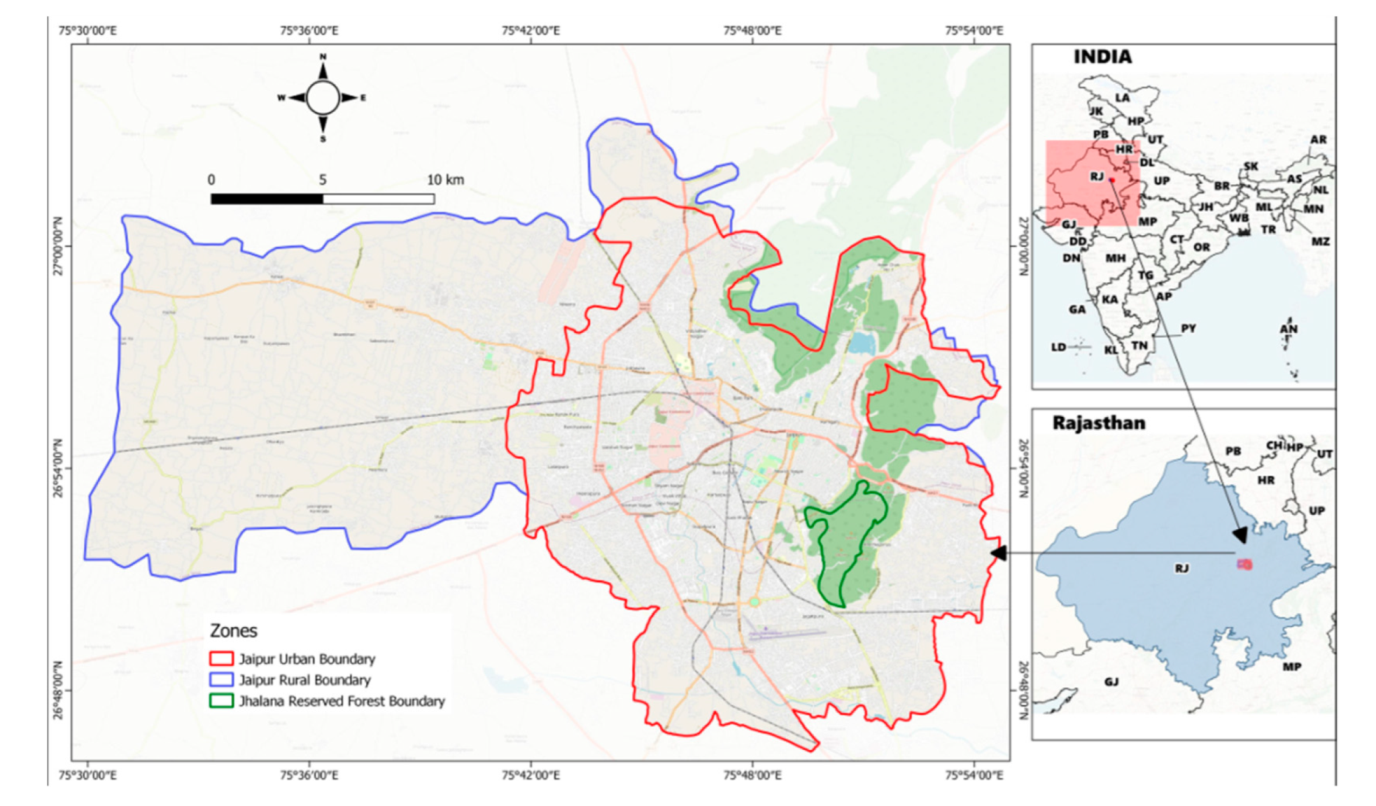
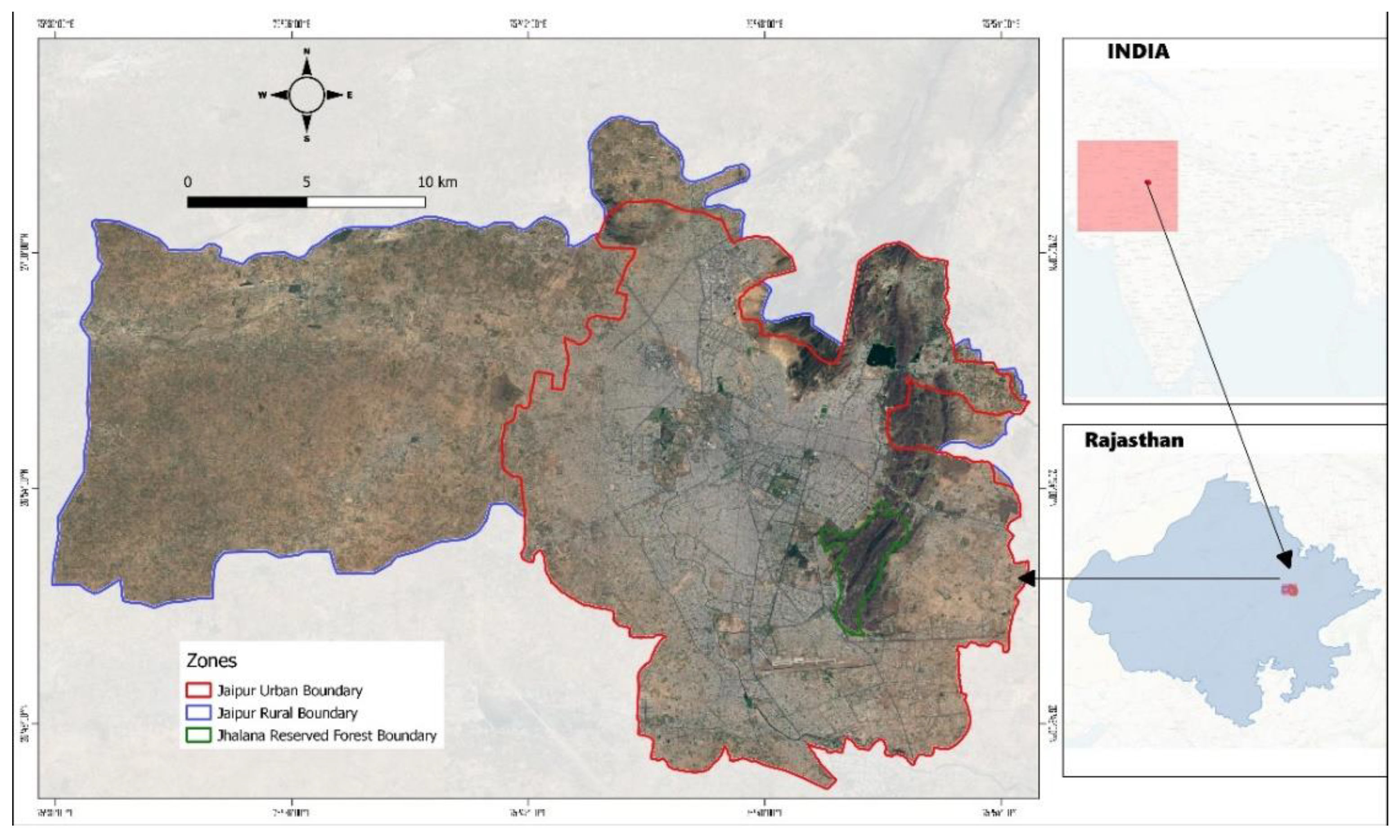
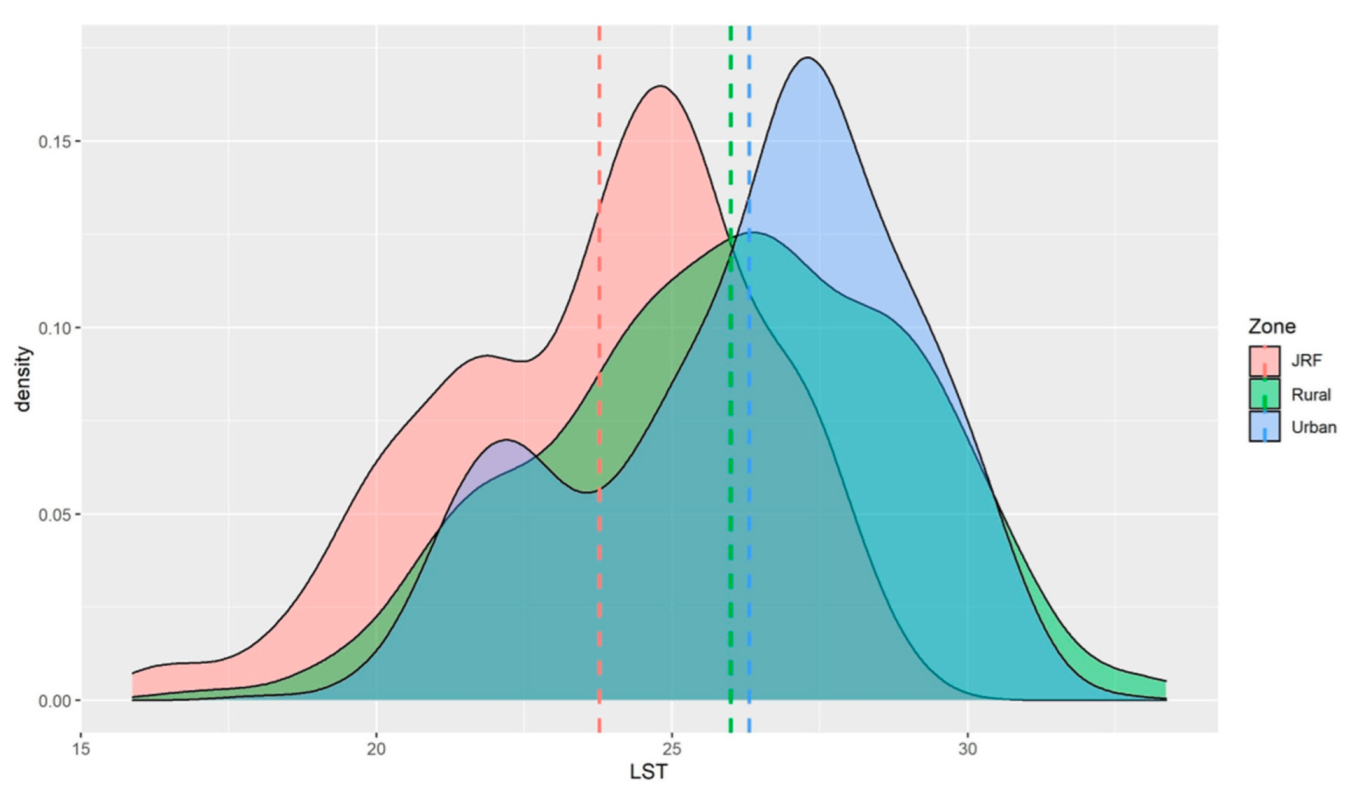
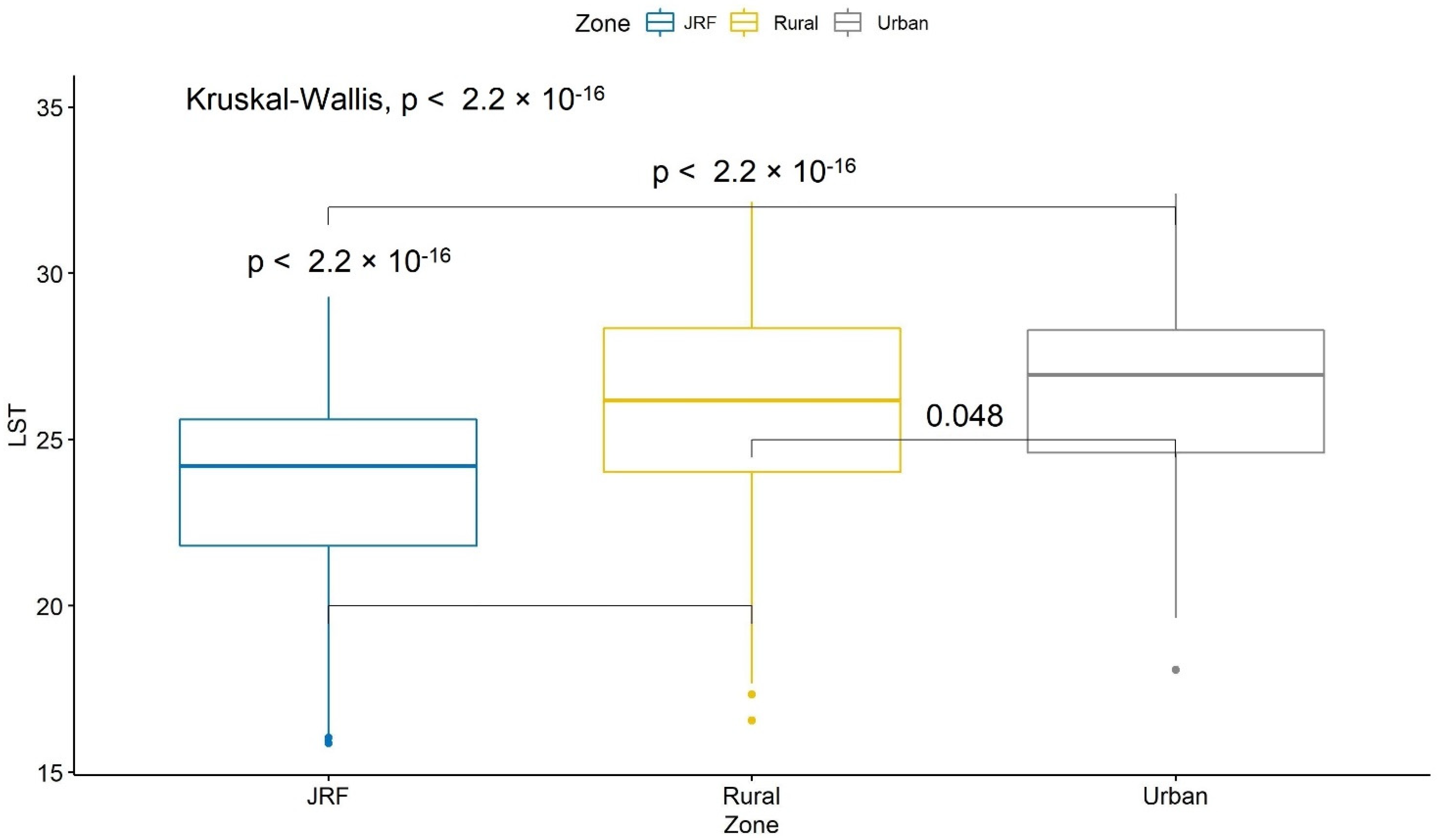
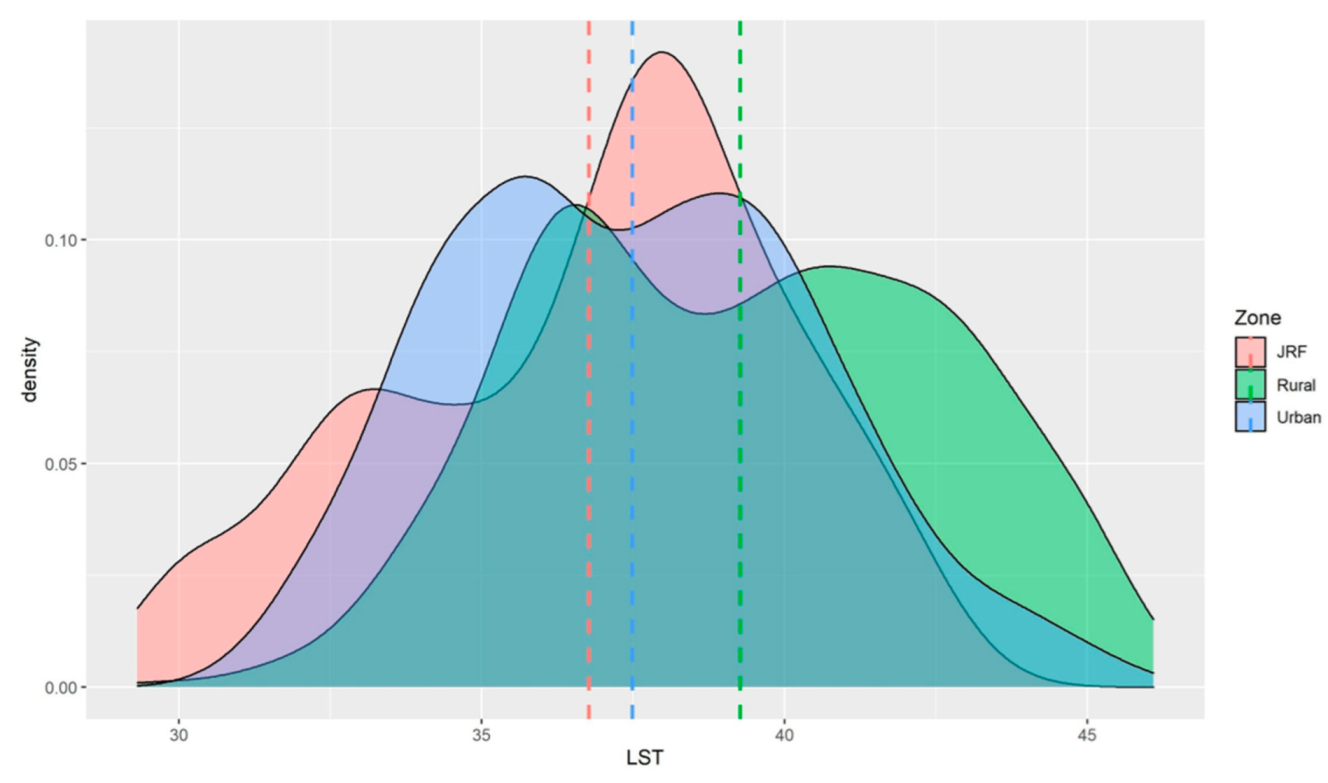
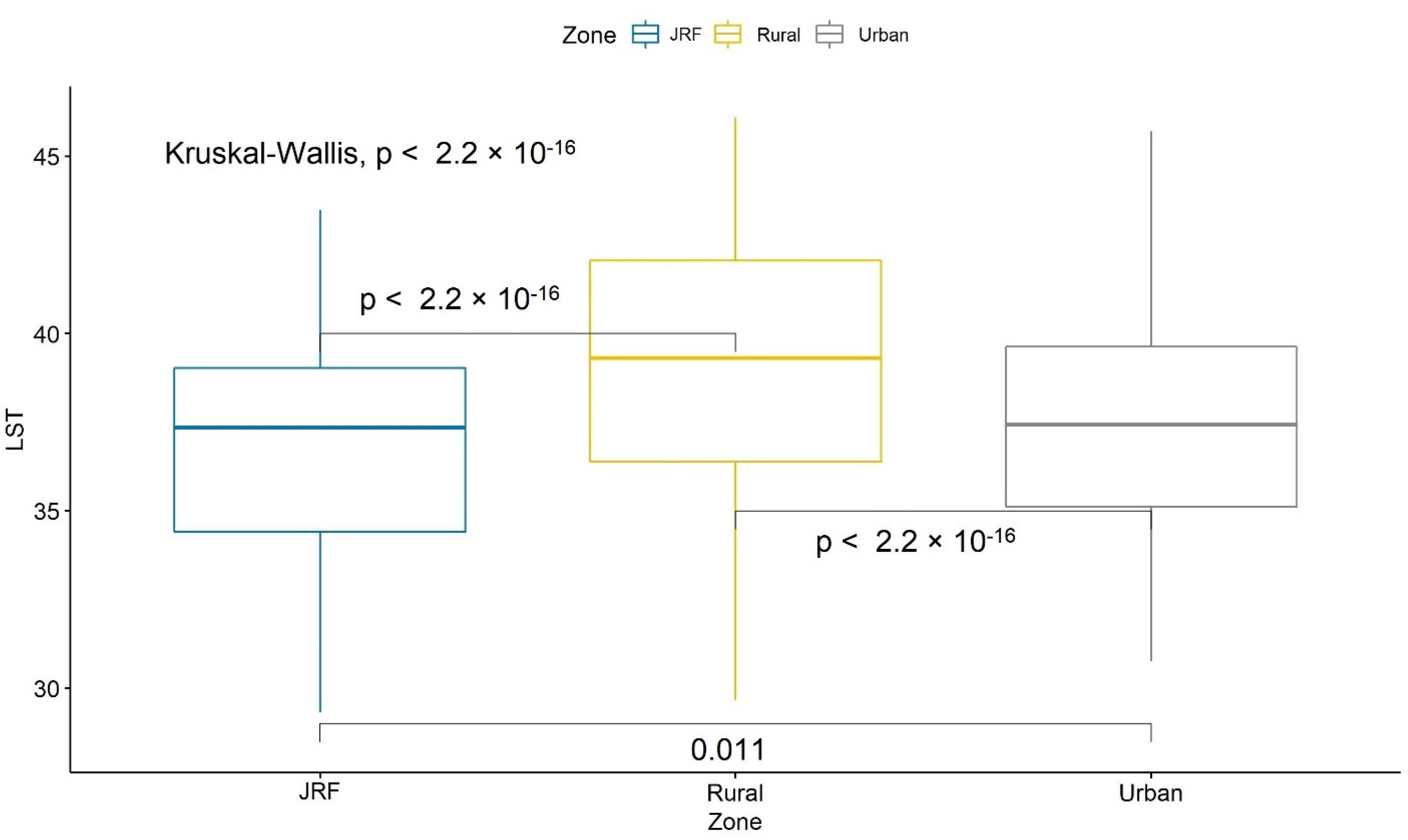


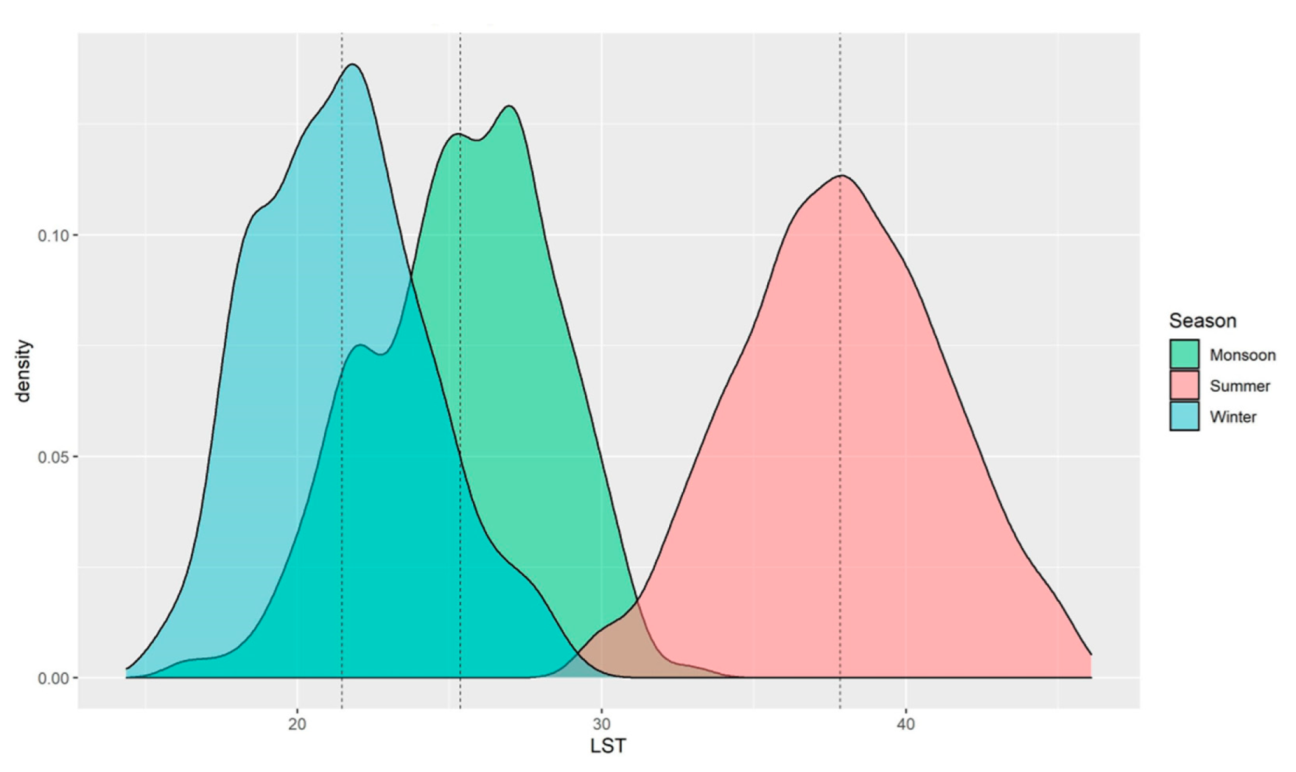
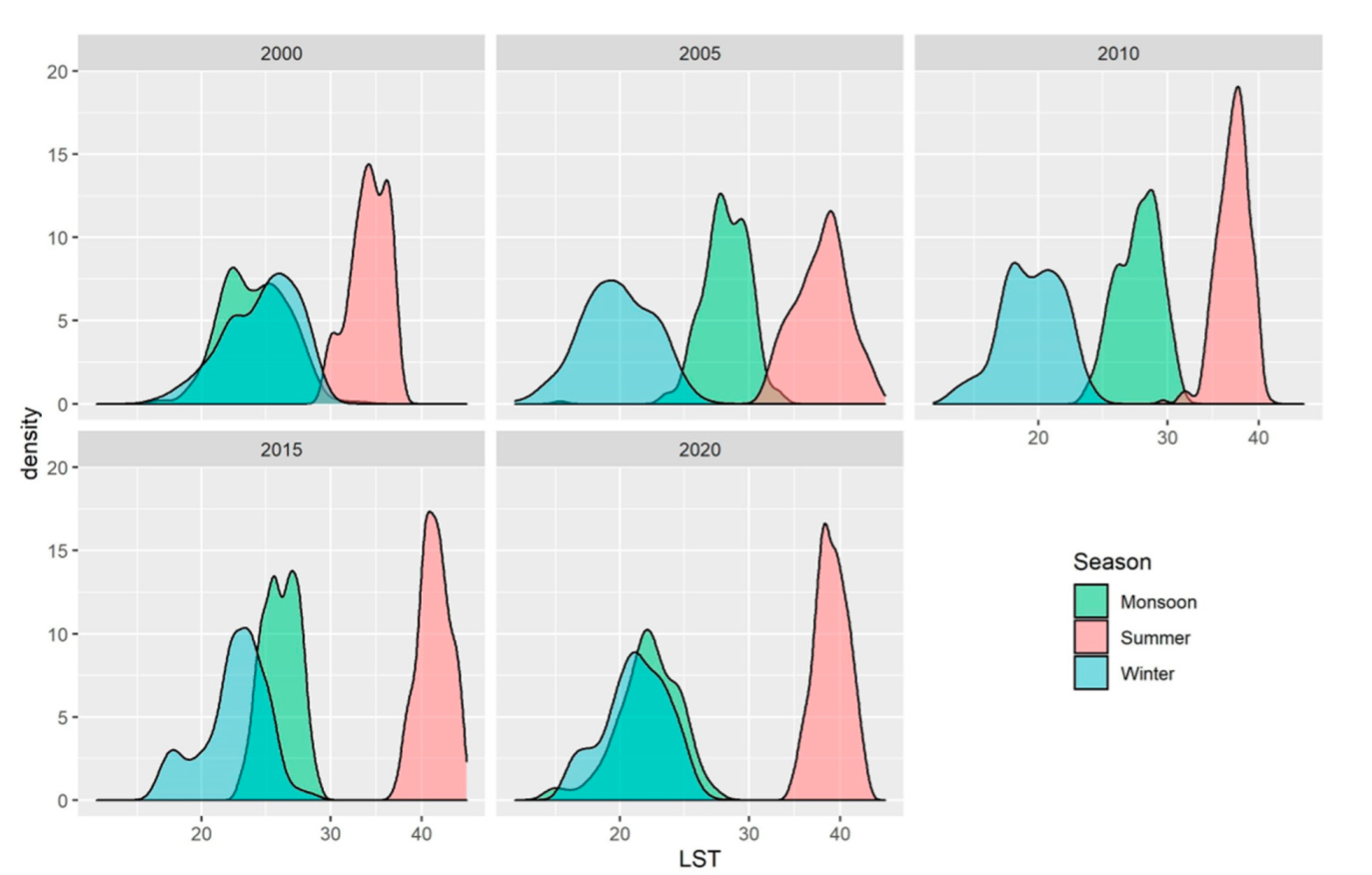

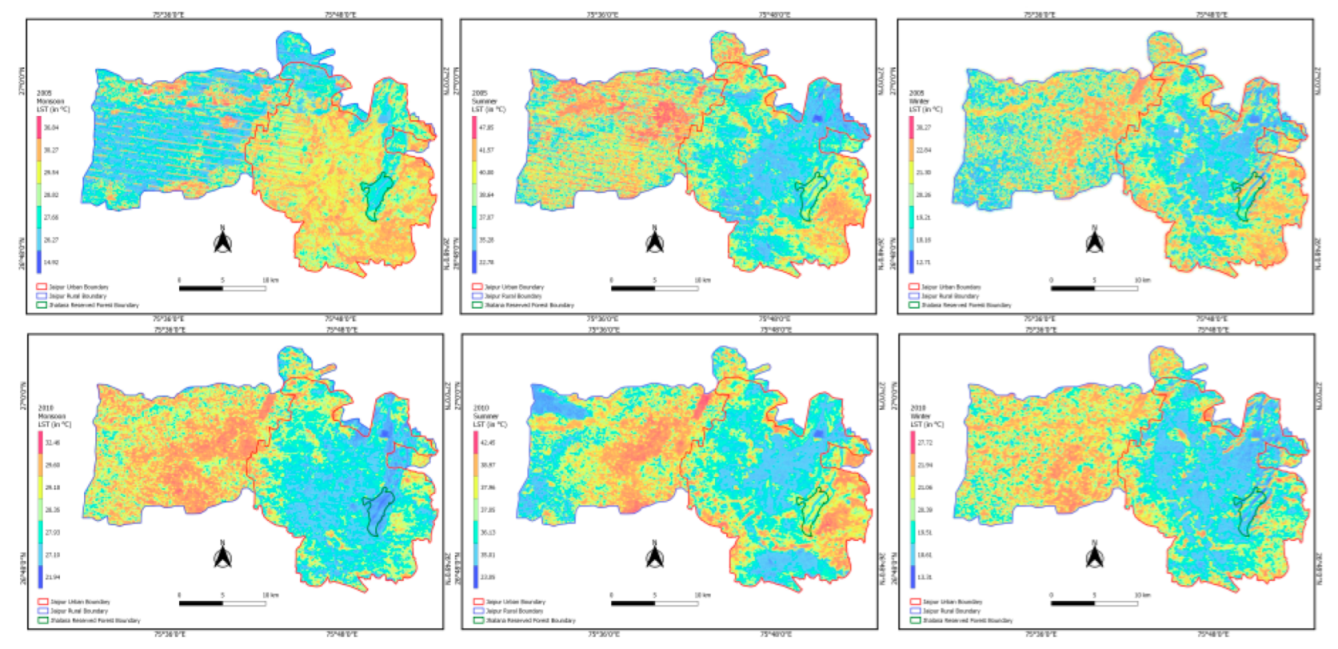

| Provisioning Services | Regulating Services | Cultural Services |
|---|---|---|
| Food | Disease regulation [43,44] | Eco-tourism and recreational aesthetics [45] |
| Fuel Wood | Trimming of dead branches | Private consumption |
| Fodder for domestic animals | Nutrient Cycling [46] | Spiritual and religious [47] |
| Medicinal Resources | Climate regulation (based on current study) | Scientific and Educational [48] |
| Public Health | Disease prevention | Medical and hygiene [44] |
| Season | Avg. Max. Temp. (°C) | Avg. Min. Temp. (°C) | Avg. Precipitation (mm) |
|---|---|---|---|
| Monsoon | 33.8 | 24.8 | 145.4 |
| Summer | 39.2 | 25.5 | 25.2 |
| Winter | 27.9 | 13.3 | 8.9 |
| Analysis Type | Components |
|---|---|
| Demi-decadal | Years: 2000, 2005, 2010, 2015, 2020 |
| Seasonal | Seasons: Summer (April–June), Monsoon (July–September), Winter (October–March) |
| Zonal | Urban, Rural, Jhalana Reserve Forest |
| Season | 2000 | 2020 |
|---|---|---|
| Monsoon | 24.65 (±SD 2.48) | 22.74 (±SD 1.64) |
| Summer | 34.69 (±SD 1.55) | 39.51 (±SD 1.98) |
| Winter | 24.94 (±SD 2.5) | 21.69 (±SD 2.21) |
Publisher’s Note: MDPI stays neutral with regard to jurisdictional claims in published maps and institutional affiliations. |
© 2022 by the authors. Licensee MDPI, Basel, Switzerland. This article is an open access article distributed under the terms and conditions of the Creative Commons Attribution (CC BY) license (https://creativecommons.org/licenses/by/4.0/).
Share and Cite
Yosef, R.; Rakholia, S.; Mehta, A.; Bhatt, A.; Kumbhojkar, S. Land Surface Temperature Regulation Ecosystem Service: A Case Study of Jaipur, India, and the Urban Island of Jhalana Reserve Forest. Forests 2022, 13, 1101. https://doi.org/10.3390/f13071101
Yosef R, Rakholia S, Mehta A, Bhatt A, Kumbhojkar S. Land Surface Temperature Regulation Ecosystem Service: A Case Study of Jaipur, India, and the Urban Island of Jhalana Reserve Forest. Forests. 2022; 13(7):1101. https://doi.org/10.3390/f13071101
Chicago/Turabian StyleYosef, Reuven, Shrey Rakholia, Abhinav Mehta, Alap Bhatt, and Swapnil Kumbhojkar. 2022. "Land Surface Temperature Regulation Ecosystem Service: A Case Study of Jaipur, India, and the Urban Island of Jhalana Reserve Forest" Forests 13, no. 7: 1101. https://doi.org/10.3390/f13071101
APA StyleYosef, R., Rakholia, S., Mehta, A., Bhatt, A., & Kumbhojkar, S. (2022). Land Surface Temperature Regulation Ecosystem Service: A Case Study of Jaipur, India, and the Urban Island of Jhalana Reserve Forest. Forests, 13(7), 1101. https://doi.org/10.3390/f13071101







